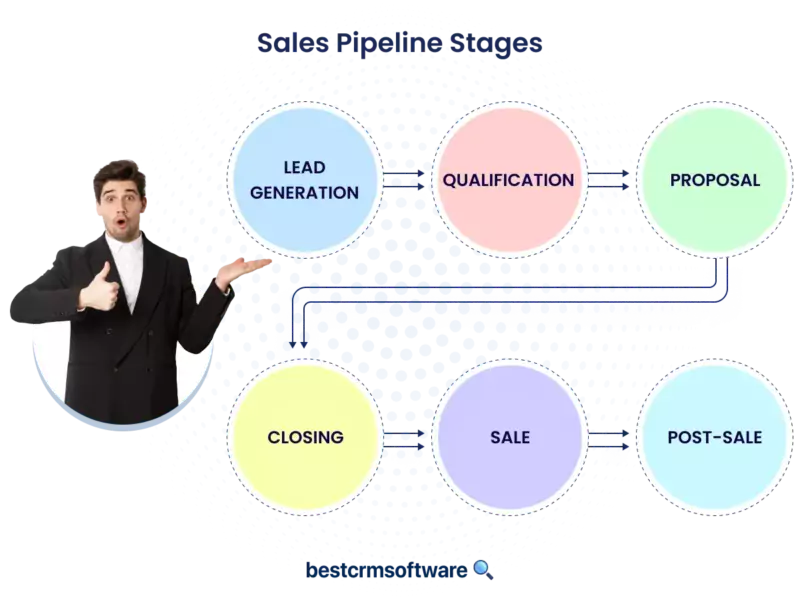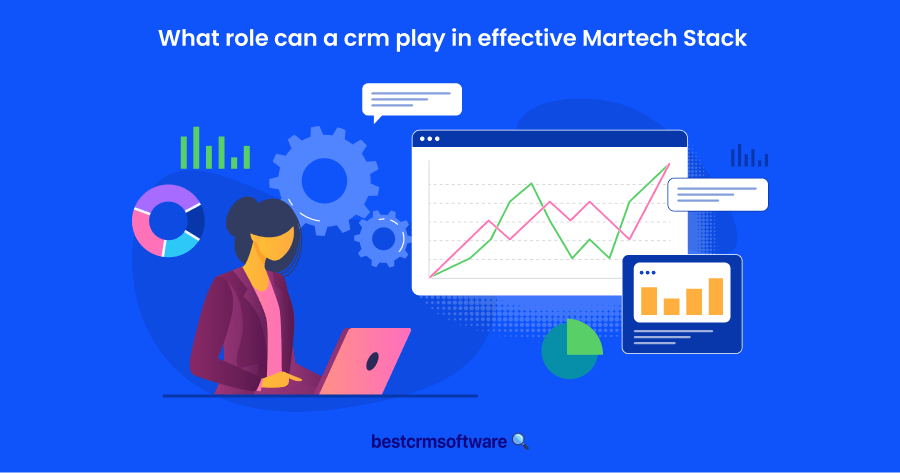
Your Ultimate Guide to Sales Pipeline Stages
Key Takeaways
- Sales pipeline entails more than just closing a deal
- The sales pipeline focuses on the stages necessary for a customer to convert
- A sales funnel represents the customer journey through the sales pipeline
- Using CRM solutions can help make sales management more efficient and boost revenue
What is a Sales Pipeline?
Mention sales and what most people think is closing a deal after a customer makes a purchase. However, the actual selling covers all the steps necessary to complete the process from start to finish.
For example, you must understand how each particular lead moves from one stage to the next until they finally make a purchase.
That’s where you need a sales pipeline. The more you understand the ins and outs of your sales pipeline, the higher your chances of converting prospects into real buyers, and the more revenue you’ll close.
To achieve that, you need strategic pipeline management. So, what is a sales pipeline? It refers to the visual presentation of where leads are in the cycle and the direction they’re likely to take. Once prospects complete specific activities (like sign-ups, demos, etc.), they keep moving down the sales pipeline. You can monitor all these activities with CRM and forecast revenue and the overall outcome of the process.
Again, you’ll be able to monitor the rate and pace at which each prospect moves down the pipeline as it varies based on their level of interest and need. Also, remember that every company is different; even if their offerings are the same, their sales processes and pipelines will be unique. Still, the customer’s journey looks like this:
- Awareness: The point where the buyer acknowledges their problem and need for a solution
- Consideration: A buyer knows their pain points and has identified the ideal solution
- Decision: The buyer has decided to solve their problem and now goes ahead to compare available offerings
Key Components of a Sales Pipeline
A sales pipeline is composed of various stages of development, each aimed at pushing the prospect down to the conversion stage. These components are classified into stages and deals.

Stages
Within stages are activities that must be carried out to ensure the process is successful; these include nurturing and strengthening relationships to ensure prospects don’t slip through the cracks.
Once a relationship has been maintained, you move to present a proposal that addresses their unique challenges and how the product will help them. Negotiating comes next after a successful pitch where you hold a strategic conversation with the prospect and present your terms, pricing, and delivery timelines.
Deals
Deal closing comes next after the prospect has committed to buying your offerings. This step is followed by a post-purchase experience where you endeavor to share tips and support, plus how the customer is progressing with the product.
Actions and Touchpoints
The sales pipeline differs from one company to the next; however, the sales process remains standardized regardless of company or industry. The usual steps involved in the sales process include:
- Prospecting: Reaching out to potential customers through lead generation
- Qualifying: Determining which leads are most likely to convert at the end of the process
- Contacting: Official communication between a sales rep and a qualified lead. It often results in scheduling a demo or an in-person meeting.
However, with deals, the focus is primarily on the deal stage, deal value, deal tracking, and deal forecasting.
Importance of a Sales Pipeline in Sales Management
Forecasting
Forecasting helped me better understand how many deals I could close on my sales pipeline depending on the number of prospects I had at different stages.
Not only was I able to estimate how close my team was to hitting the first quota, but predicting future sales targets was also straightforward. Plus, it was easier to know which areas needed improvement as far as targeting revenue was concerned.
Prioritization
Ideally, a sales pipeline presents the status of each prospect at every stage. I could clearly see which prospects had developed the most interest and would move down to the next stage without much prodding, making prioritization easy.
Efficiency
Working with a sales pipeline helps keep the entire sales process organized and less chaotic. A clear view of where I was with each prospect in the initial stages ensured no prospect data was mixed up. Plus, I could easily let go of unpromising leads without compromising the most qualified ones.
Sales Pipeline vs. Sales Funnel
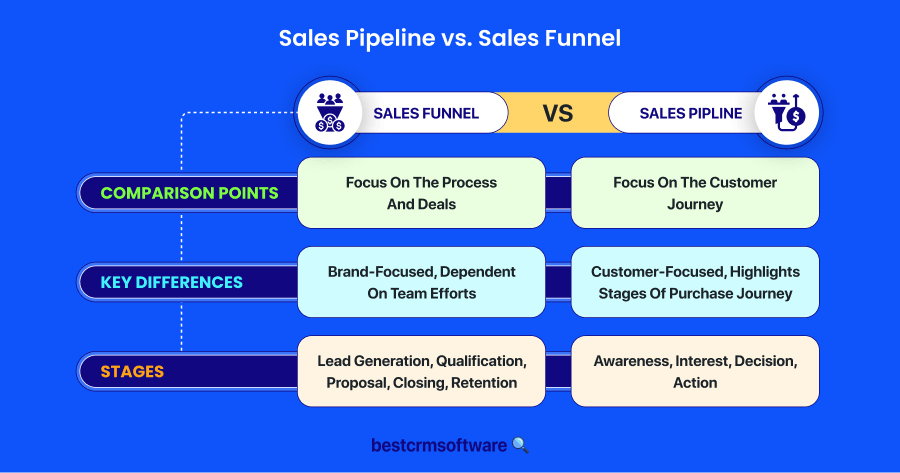
Most people tend to confuse a sales pipeline with a sales funnel. While both are crucial stages of compelling customers to part with their money, they’re two distinct approaches. A sales funnel focuses more on leads, while a sales pipeline is all about deals.
A sales pipeline is the process a prospective client moves through from the moment they show interest in a product or service to the point they part with their money. A sales funnel, on the other hand, represents how many prospects actually move from the top to the bottom of the funnel.
Focus of a Sales Pipeline
A sales pipeline is a brand-focused process where the probability of the customer transitioning from a mere lead to a client is dependent on the team’s efforts.
A sales funnel is the ultimate customer journey that highlights the stages the customer will move through to finally make the purchase, so it’s entirely customer-focused. If we outline each stage, we’ll see a contrasting difference between a pipeline and a funnel. Let’s take a look.
Lead generation
The first and most crucial step in the sales pipeline is all about identifying the people to pitch your offerings to. After identification follow the steps to reaching them, which again entails compiling their personal data such as contacts, demographics, and persona.
Qualify leads
Lead qualification through lead scoring helps gauge their level of interest and likelihood of them buying at the end of the pipeline.
Call or meeting
This is the first official communication to ascertain the client’s needs and how best the product or service will meet those needs. The success of this step determines whether the prospect will move to the next stage.
Proposal
Presenting the offerings complete with quotes, cost terms, and duration of contract.
Closing
Wrapping up negotiations, signing contracts, delivering products, and smiling merrily to the bank.
Retention
Retention may not be an integral part of the sales pipeline, but it’s a crucial step worth factoring in as it reduces the need for additional marketing in the long run.
Focus of a Sales Funnel
The sales funnel is the entire customer journey and doesn’t necessarily outline the six sales pipeline stages. Rather, it typically leans towards Awareness, Interest, Desire, and Action AIDA – but mostly follows three notable stages, namely:
- Top of the funnel (TOFU): This is the awareness stage where the lead has been drawn into the loop through marketing.
- The middle of the funnel (MOFU): The lead is expressing intent and an interest in doing business at this stage.
- The bottom of the funnel (BOFU) marks the end of the customer journey as they make the purchase and factor in loyalty.
Conversion Rates and Volume
In an ideal sales process, conversion rates are determined by measuring existing customers against qualified leads. A conversion should take place between every sales stage. With each improvement you make on the sales conversation rate, you’re basically targeting more sales from the same existing customers instead of adding the volume of leads down the pipeline.
This approach tends to be more successful when a conversion rate optimization (CRO) process is applied. It involves site analysis to determine why prospects aren’t moving down the pipeline. It’s at this point where solutions like A/B testing come in to try to pinpoint the problem.
Integrating Pipeline and Funnel for Optimal Results
To keep sales pipelines and marketing funnels optimally aligned, I made sure to follow best practices such as:
- Establishing buyer personas
- Defining buyer pain points
- Mapping out sales pipeline and funnel stages and integrating them
- Establishing a clear criteria for lead generation and scoring,
- Investing in the necessary tools for integration and automating sales activities
- Tracking and measuring performance
- Regularly reviewing and refining the sales pipeline and marketing funnel to pinpoint what works and what doesn’t.
Next up was utilizing complementary tools including:
Customer Relationships Management (CRM)
The most effective tools when it comes to building an effective sales strategy are CRM systems with which you can track website visitors’ journeys, noting their behavior and engagements with your content and other offerings. From there, you can reach out based on their activities.
Email finder
Utilizing various email finder tools proved super effective in finding private emails of the most promising prospects, which would otherwise have been time-consuming had I gone the manual way. It saved me the pain of misinformation, wrong contact details, and guesswork.
Email outreach
Once you’ve nailed the right people, there follows email outreach, which is all about sending personalized emails, building rapport, and engaging the prospect to push them down the pipeline. And it only gets better when you’re able to track campaigns, evaluate performance, and optimize content all with automation.
Social media
There’s no underestimating the power of social media in marketing. This is where I gleaned most of my organic leads and learned about their interests and pain points. And yes, this is where you can establish yourself as an authoritative and credible figure in the industry with, you guessed right, valuable organic and timely content.
Strategic Insights
Strategic insights mean having an eagle-eye view of what needs to be done to accelerate the rate at which prospects transition into buyers. Without these insights, the business suffers inefficiencies, low sales, and stagnation.
Here are some strategic insights I employed.
Fostering Alignment Between Marketing and Sales
To maintain your revenue targets and minimize losses, your sales and marketing strategies should collaborate efficiently. Collaboration means seamless tool integrations, open communication among teams, clearer roles, and common goals.
Harnessing the Power of Data Analytics
Data is key at each stage of the sales pipeline. Without clear information on a lead’s status and interest level, you can’t know which one to move, which one to retain, and which one to let go. Data analytics also comes into play when you need to pinpoint bottlenecks, make priorities, and review the efficiency of your strategy.
All Sales Pipeline Stages Highlighted
Here are the stages that define a sales pipeline.
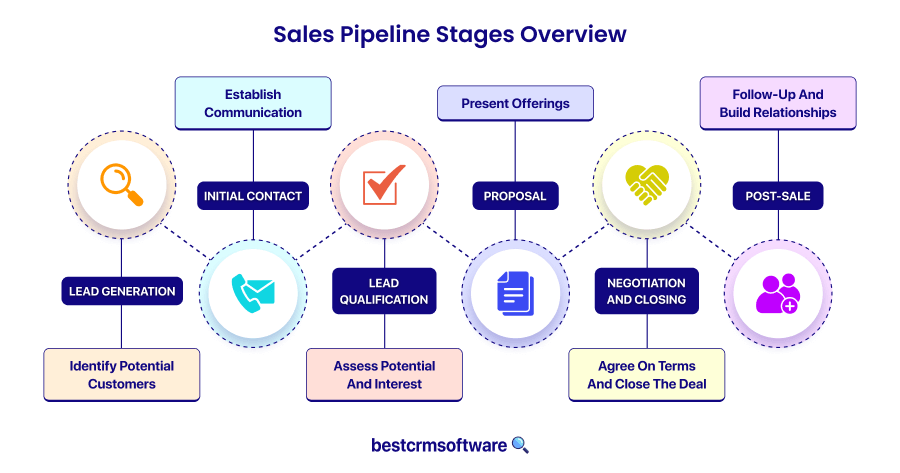
Lead Generation
Identifying Potential Leads
This is by far the first stage of the sales pipeline. It entails researching and identifying prospective customers who have exhibited a genuine interest in your offerings and collecting their data for possible outreach.
Generating leads can be made possible by employing various strategies to elicit interest, such as paid advertising, content marketing, social media, and word of mouth.
Initial Contact
Once a prospect has been identified, an initial contact must be made to establish a business relationship and collect additional information about their needs or problems they wish to solve. Again, this is achieved through calls, emails, or physical meetings.
Lead qualification
Assessing Lead Potential
Assessing lead qualification to determine if they’re fit and interested in moving down the sales funnel is crucial and best achieved with CRM software.
Fit and Interest
After the initial contact, lead qualification determines if the prospect is worth pursuing. What are their pain points, and how can your offerings solve them? Do they have the budget for the product?
The most qualified leads must meet certain requirements that indicate the possibility of making a purchase. A good example is budget and urgency. If they lack sufficient resources to invest in the product or if they are not keen on making a purchase soon enough, that’s where they’re disqualified.
Proposal
So, now your lead qualification assessment shows that the prospect is financially fit and interested in doing business. Having understood their needs, you make a proposal detailing the benefits of your offerings and how they will help them. This basically addresses the prospects’ concerns and presents solutions.
Negotiation and Closing
This stage is all about negotiating the terms of your business, such as pricing, delivery, and timelines, and then reaching an agreement with the prospect. You close the deal once you both agree.
Finalizing the Deal
This is one of the last stages where you’ve won or lost the prospect. If it’s a deal, you move to the next stage of fulfilling the client’s order and collecting their feedback. Otherwise, you close the sales process and repeat it with other qualified leads.
Post-Sale
Follow-Up and Relationship Building
This is the last stage of a successful sales pipeline. The client has already made the purchase, the orders have been fulfilled, and all you have to do now is keep the communication channels open where you constantly contact the client to provide tips, ascertain their satisfaction, and identify opportunities for more business.
This stage is crucial for maintaining a good rapport with the customer, especially if you’re keen on up-selling and cross-selling the client. Usually, all it takes is a follow-up email to check their progress with the product and provide helpful customer support.
How to Build a Sales Pipeline
To successfully build a sales pipeline, you must be conversant with several crucial steps including:
Defining Your Sales Process
Start by defining the entire process. List the steps and tasks that must be executed from start to finish. For example, determine what needs to be done to identify a prospect to close the deal, keeping everything organized until the last stage.
Identifying Key Stages and Milestones
With a workable sales process mapped out, start by completing each stage individually, evaluating your progress as you move. For example, in the stages highlighted above, you can only propose once you’re certain your potential lead is fit and qualified to receive your offerings.
The same is true for all the stages. As you move to each stage, always remember your goals for moving to the bottom of the sales funnel: making a sale and collecting revenue from the customer. Ensure every stage and milestone aligns with this goal.
Implementing a CRM System
Use a CRM solution to organize each stage inside a sales pipeline. Set up automation and track KPIs to improve efficiency and overall outcome.
Monitoring and Optimizing the Pipeline
As with everything else, the first sales pipeline isn’t always the best. However, it provides an opportunity for learning and improvement. You can keep testing and adjusting your sales pipeline to ensure it’s up to date and aligns with your sales process.
Benefits of a CRM Sales Pipeline
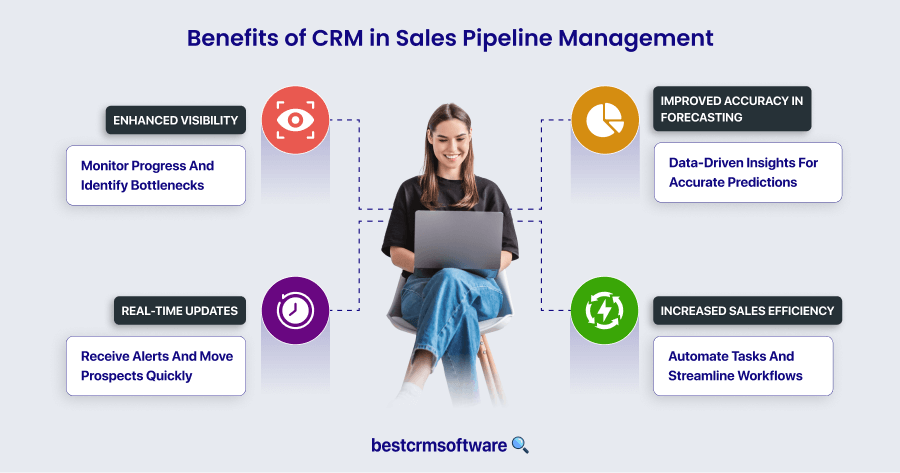
Using CRM software in your sales pipeline has several benefits, from keeping your data clean and organized to boosting productivity, automating tasks, and streamlining processes. Let’s look at some of these benefits.
Enhanced Visibility
Working with CRM allowed me to monitor the progress of each sales rep at every stage of the sales pipeline. I identified bottlenecks and areas that need improvement, which are great drivers of sales performance and revenue growth.
With enhanced visibility comes increased transparency, another crucial factor in making data-driven decisions. From this, I could spearhead targeted support and coaching for the team, leading to improved productivity.
Real-Time Updates
Using a CRM solution in sales pipeline stages helps save time since teams can receive real-time updates on the status of each stage.
For example, receiving alerts on which prospects have shown the most interest in a product signals that it’s time to move them to the next prospecting stage. This allows teams to move faster down the sales funnel and close more deals quickly.
Improved Accuracy in Forecasting
Data-Driven Insights
With a CRM solution, every insight gleaned from the sales pipeline at every stage, be it lead generation, prospecting, qualification, or proposal, is backed by accurate and up-to-date data. This means teams can take calculated steps, minimizing the risk of errors and losses.
Trend Analysis
Use a CRM software solution to analyze social and market trends that directly or indirectly affect lead qualification. It could be customer preferences, competition, pricing, or demand. A trend analysis lets you know where your product stands in the market, your target customer’s preferences, prices, and purchasing power.
It also shows prospects’ past interactions with your products and how they’re likely to behave in the future. You can then tailor your current offerings based on these factors.
Increased Sales Efficiency and Productivity
Automating tasks and streamlining workflows with CRM software make every sales process efficient, time-efficient, and cost-effective. It relieves your sales team of time-consuming administrative tasks, allowing them to focus more on actual sales and revenue growth.
Best Practices
If successfully implemented, a workable sales pipeline strategy will benefit the entire organization and not just the sales department. When everyone is focused on maximizing revenue goals, success is a guarantee.
However, a few crucial best practices for implementing a sales pipeline must be followed. Here are a few examples, plus tips for serving prospects and empowering teams for success.
Regular Pipeline Reviews
Assessing Pipeline Health
A dry sales pipeline can only spell doom for your processes and revenue flows, and you don’t want that. To avert such a scenario, conducting regular meetings and reviews is vital. It is from such reviews that I was able to understand the status of every single deal we prospected and how effective the team was.
I endeavored to inspect the sales pipeline every month, which was combined with biweekly team meetings where we brainstormed new ideas, identified new opportunities, and sealed possible loopholes. These steps ensured that we kept the pipeline active even during downtimes rather than being stagnant.
Identifying Blockages and Opportunities
How healthy is your sales pipeline? Is it flowing smoothly or blocked by stagnant leads? Assess the health of your pipeline by measuring metrics and reports. Sometimes, I found deals that had been stagnant inside the pipeline for weeks without a clear indication of moving to the next stage.
To avoid unnecessary blockages I’d review the lead’s status and determine whether to drop or move them down the pipeline. It also prompted me to encourage the team to focus on quality above quantity. Few but profitable leads will always win over many unqualified ones. Still even having the most qualified leads means you’ll have to let some go especially if they get stuck at the proposal stage.
This was the most difficult part since time and resources had been invested in nurturing and maintaining a relationship with these leads. Here are a few pointers on how to let go of a lead:
- They can’t be reached through the available communication channels
- They’ve indicated a lack of interest
- They’re reluctant to move down to the next stage
Letting go, though difficult, is necessary if you’re going to dedicate your time and resources to something that brings value.
Maintaining Data Accuracy
Up-to-Date Information
The sales pipeline doesn’t end after all deals have been closed. As long as your business offers a solution to a specific problem, new leads will always come in as older ones are moved down the pipeline.
Clean and Organized Data
If you’re not careful in maintaining data accuracy the process may become chaotic and disorganized. This will not only mess up your strategy but will compromise your efforts and expected revenue outcomes.
The inefficiency will cost your business big time. You want to avoid that by keeping everything organized and efficient using a CRM solution. It’s the one tool that guarantees up-to-date data on every single lead you onboard.
Continuous Training and Development
Sales Process Adherence
Having an experienced team conversant with the sales processes and necessary tools places your business on a winning trajectory. During the earliest stages of mapping out our first-ever sales pipeline, I had to take my team through rigorous training and orientation just to be sure I was working with a dependable team that knew how to build and utilize the sales pipeline effectively.
Skill Enhancement
Ensure they’re conversant with case studies, documentation, user responsibilities, and overall pipeline management. Besides offering practical training at the onboarding phase, emphasize the importance of adhering to strict sales processes set out in your strategy and staying updated on new developments.
Leveraging Technology
CRM Utilization
Software solutions are instrumental in improving the sales process. You can utilize these to your advantage by improving team performance and efficiency in each process. A good example of such tools include :
- Customer relationships management system or CRM
- Sales coaching platforms
- Sales enablement tool
- Sales analytics and business intelligence tools
These digital marketing solutions helped me stay on top of the most qualified leads within the sales pipeline and kept them moving with little to no stagnation.
Automation Tools
When starting in the sales pipeline journey, I had an easy time working with so few leads that were available at the time. However, as more and more leads joined the pipeline, managing them efficiently became more challenging.
That’s when I went full throttle into sales automation and saved more time on redundant sales activities. In the end, I managed to onboard more leads, which were quickly pushed down the pipeline as time and costs became more efficient.
Sales automation is great for helping teams easily achieve targets, and I recommend it if you want to propel your business forward effectively.
Explore our other blogs too! Our CRM experts publish helpful content daily, covering everything from how-to guides to in-depth articles on CRM processes.


